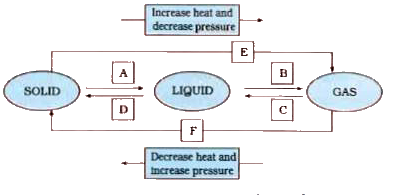Complete Solutions to QUESTIONS AND ANSWERS (ANSWER THE FOLLOWING QUESTIONS IN SHORT) of chapter MATTER IN OUR SURROUNDINGS of Class 9 book with complete answers and questions
| Class 9 | CHEMISTRY |
| Chapter | MATTER IN OUR SURROUNDINGS |
| KUMAR PRAKASHAN | QUESTIONS AND ANSWERS (ANSWER THE FOLLOWING QUESTIONS IN SHORT) |
| Number Of Questions | 14 |
| Academic Year | 2023-24 |
How does the rate of diffusion change wth temperature?
View SolutionGive one similarity and one dissimalarity between a liquid and a gas.
View SolutionWhy is the rate of diffusion faster in gases?
View SolutionWhy is ice at 273 K more effective in cooling than water at the same temeperature?
View SolutionWhat produces more severe burns, boiling water or steam? OR
Explain steam at `100^(@)`C causes more severe burns than the water at the same temperature.
View SolutionName A,B,c,D,E and F in the following showing the change in its state:

View SolutionHow does the melting point of a substance indicate the strength of its intermolecular force of attraction?
View SolutionIn winter, thee freezes at room temperature but groundnut oil (or mustard oil/sesame oil) does not. Explain.
View SolutionWhich phenomeon occurs during the following changes?
1. formation of clouds, 2 Drying of wet clothes, 3. Wax melts in the sun, 4. The size of naphthalene balls decreases.
View SolutionName the factors that affect the rate of evaporation.
View SolutionHow is the high compressibility of gases useful to us?
View SolutionStates the differences between solid and gasesous states on the basis of 1 intermolecular space and 2. compressibility.
View SolutionWhen a solid melts its temperature remains the same. So where does the heat energy go? What is the name given to this heat?
View SolutionDoctor advises to put strips of wet cloth on the forehead of a person having high temperature. Explain.
View Solution
QUESTIONS AND ANSWERS (ANSWER THE FOLLOWING QUESTIONS IN SHORT) questions and complete solutions for chapter MATTER IN OUR SURROUNDINGS of KUMAR PRAKASHAN KENDRA CHEMISTRY (GUJRATI ENGLISH) of Class 9
All Exercises from KUMAR PRAKASHAN Class 9 CHEMISTRY MATTER IN OUR SURROUNDINGS
- ACTIVITY
- INTEXT QUESTIONS AND ANSWERS
- QUESTION BASED ON PRACTICAL SKILLS WITH ANSWER
- QUESTIONS AND ANSWERS (ANSWER THE FOLLOWING QUESTIONS IN BRIEF)
- QUESTIONS AND ANSWERS (ANSWER THE FOLLOWING QUESTIONS IN DETAIL)
- QUESTIONS AND ANSWERS (ANSWER THE FOLLOWING QUESTIONS IN DETAIL:)
- QUESTIONS AND ANSWERS (ANSWER THE FOLLOWING QUESTIONS IN SHORT)
- QUESTIONS AND ANSWERS (ANSWER THE FOLLOWING QUESTIONS IN VERY SHORT)
- QUESTIONS AND ANSWERS (CHOOSE THE CORRECT OPTION FROM THOSE GIVEN BELOW EACH QUESTION:)
- QUESTIONS AND ANSWERS (DISTINGUISH BETWEEN THE FOLLOWING)
- QUESTIONS AND ANSWERS (FILL IN THE BLANKS BY SELECTING THE CORRECT ALTERNATIVE FROM THOSE GIVEN IN THE BRACKET:)
- QUESTIONS AND ANSWERS (FILL IN THE BLANKS:)
- QUESTIONS AND ANSWERS (GIVE DEFINITION OF THE FOLLOWING:)
- QUESTIONS AND ANSWERS (GIVE SCIENTIFIC REASONS FOR THE FOLLOWING STATEMENTS )
- QUESTIONS AND ANSWERS (MATCH THE FOLLOWING PROPERLY:)
- QUESTIONS AND ANSWERS (STATE WHETHER THE FOLLOWING STATEMENTS ARE TRUE OR FALSE:)
- VALUE BASED QUESTIONS WITH ANSWER